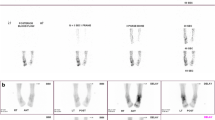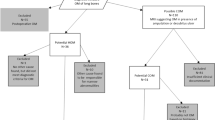Abstract
Introduction
Post-poliomyelitis syndrome causes variable musculoskeletal manifestations including pain, muscle weakness and fatigue. These manifestations are commonly secondary to overuse and misuse of muscles and joints and could follow a fall. Bone scan can be useful in determining the underlying cause and follow-up. The objective of this study was to describe the late scintigraphic patterns on bone scan following poliomyelitis.
Materials and methods
Bone scans of 8 adult patients (7 female and 1 male), aged 35 to 53 years, who were known to have paralytic poliomyelitis, were retrospectively studied. Six patients had unilateral while 1 had bilateral disease. All patients had three-phase bone scan and 5 had SPECT study as well. Studies were reviewed by two qualified nuclear medicine physicians and findings were recorded and analyzed.
Results
Several patterns were consistently identified: decreased blood pool activity in the affected lower limb of all patients; deformed ipsilateral hemi-pelvis with reduced uptake on the affected side in all patients with unilateral disease; stress changes with increased uptake in the bones of the contra-lateral lower extremity; and degenerative changes in multiple joints (shoulder, knee, hip, ankle and spine). Significant scoliosis was only noted in the patient with bilateral disease.
Conclusion
Scintigraphic patterns on bone scan associated with the post-poliomyelitis syndrome and persistent weakness following a distant episode of poliomyelitis have been described. Awareness of these characteristic scintigraphic findings may facilitate an accurate diagnosis and lead to more appropriate patient management.


Similar content being viewed by others
References
Tulchinsky TH. Polio eradication: end-stage challenges. Bull World Health Organ 2004; 82:1–70.
John TJ. A developing country perspective on vaccine associated paralytic poliomyelitis. Bull World Health Organ. 2004;82:53–7.
John TJ. Vaccine-associated paralytic polio in India. Bull World Health Organ. 2002;80:917.
Technical Consultative Group to the World Health Organization on the Global Eradication of Poliomyelitis. ‘‘Endgame’’ issues for the global polio eradication initiative. Clin Infect Dis 2002; 34: 72–7.
Strebel PM, Sutter RW, Cochi SL, Biellik RJ, Brink EW, Kew OM. Epidemiology of poliomyelitis in the United States one decade after the last reported case of indigenous wild virus-associated disease. Clin Infect Dis. 1992;14:568–79.
Nkowane BM, Wassilak SG, Orenstein WA, Bart KJ, Schonberger LB, Hinman AR. Vaccine-associated paralytic poliomyelitis. United States: 1973 through 1984. JAMA. 1987;257:1335–40.
Resnick D. Neuromuscular disorders. In: Resnick D, Niwayama G, editors. Diagnosis of bone and joint disorders, 4th edition. New York: Saunders; 2001. p. 916–29.
Farbu E, Gilhus NE, Barnes MP, Borg K, de Visser M, Driessen A, et al. EFNS guideline on diagnosis and management of post-polio syndrome. Report of an EFNS task force. Eur J Neurol. 2006;13:795–801.
Klein MG, Keenan MA, Esquenazi A, Costello R, Polansky M. Musculoskeletal pain in polio virus survivors and strength-matched controls. Arch Phys Med Rehabil. 2004;85:1679–83.
Nielson NM, Rostgaard K, Askgaard D, Skinhoj P, Aaby P. Life-long morbidity among Danes with poliomyelitis. Arch Phys Med Rehabil. 2004;85:385–91.
Jubelt B. Post-polio syndrome. Curr Treat Options Neurol. 2004;6:87–93.
Fisk J, Hatfield D. Anterior horn cell diseases. In: Fitzgerald RH, editor. Orthopedics. St. Louis: Mosby; 2002. p. 1551–8.
Bruno RL, Johnson JC, Berman WS. Vasomotor abnormalities as post-polio sequelae: functional and clinical implications. Orthopedics. 1985;8:865–9.
Joyce JM, Conrad G, Shih WJ, Ryo UY. Arterial thrombosis and insufficiency causing diffusely decreased uptake by skeleton of a limb. Semin Nucl Med 1991;21:165–6.
Goerss JB, Atkinson EJ, Windebank AJ, O'Fallon WM, Melton LJ. Fractures in an aging population of poliomyelitis survivors: a community-based study in Olmsted County, Minnesota. Mayo Clin Proc. 1994;69:333–9.
Slavin JD, Peracha HU, Spencer RP. Reduced accumulation of 99mTc-MDP in the leg related to vascular occlusion. Clin Nucl Med. 1987;12:971.
Lee DY, Choi IH, Chung CY, Cho TJ, Lee JC. Fixed pelvic obliquity after poliomyelitis: classification and management. J Bone Joint Surg Br. 1997;79:190–6.
O'Brien JP, Dwyer AP, Hodgson AR. Paralytic pelvic obliquity. Its prognosis and management and the development of a technique for full correction of the deformity. J Bone Joint Surg (Am). 1975;57:626–31.
Author information
Authors and Affiliations
Corresponding author
Rights and permissions
About this article
Cite this article
Marafi, F.A., Al-Said Ali, A., Esmail, A.A. et al. Baseline patterns of bone scintigraphy in patients with established post-poliomyelitis paralysis. Skeletal Radiol 39, 891–895 (2010). https://doi.org/10.1007/s00256-009-0739-1
Received:
Revised:
Accepted:
Published:
Issue Date:
DOI: https://doi.org/10.1007/s00256-009-0739-1




